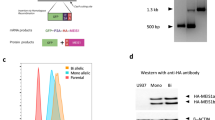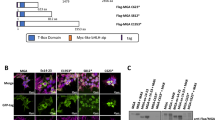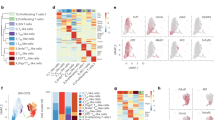Abstract
CD160 is a glycosylphosphatidylinositol-anchored multimer expressed at the cell surface of subsets of cytotoxic T-lymphocytes and natural killer cells. Although CD160 is an important molecule for the control of cell-mediated cytotoxic responses, the mechanisms of regulation of its expression is unknown. We investigated the regulation of CD160 transcription by localizing and analyzing its promoter. The CD160 gene is encoded on chromosome 1, contains 6 exons with the translation initiation codon in exon 3. Bioinformatics analysis pointed to three potential promoter regions, two upstream of exon 1 and one in front of exon 3. RACE-PCR analysis identified a single transcription start site (TSS) and reporter gene transfections localized the active region immediately upstream of exon 1. Sequential deletion analysis led to the identification of a 371 bp sequence, located between −314 and +57 relative to the TSS, as the core promoter sequence driving CD160 gene transcription. Sequence alignment of the mouse and human CD160 genomic promoter region revealed a strong homology in the 371 bp sequence identified and pointed out to three conserved transcription factor binding sites for acute myelogenous leukemia-1 (AML-1), FREAC-4 and Sox17. Site-directed mutagenesis showed that the predicted AML-1 site is essential for the regulation of CD160 gene expression.
This is a preview of subscription content, access via your institution
Access options
Subscribe to this journal
Receive 6 digital issues and online access to articles
$119.00 per year
only $19.83 per issue
Buy this article
- Purchase on Springer Link
- Instant access to full article PDF
Prices may be subject to local taxes which are calculated during checkout







Similar content being viewed by others
References
Schmitt C, Ghazi B, Bensussan A . NK cells and surveillance in humans. Reprod Biomed Online 2008; 16: 192–201.
Braud VM, Allan DS, O'Callaghan CA, Soderstrom K, D'Andrea A, Ogg GS et al. HLA-E binds to natural killer cell receptors CD94/NKG2A, B and C. Nature 1998; 391: 795–799.
Colonna M, Samaridis J, Cella M, Angman L, Allen RL, O'Callaghan CA et al. Human myelomonocytic cells express an inhibitory receptor for classical and nonclassical MHC class I molecules. J Immunol 1998; 160: 3096–3100.
Lanier LL . NK cell recognition. Annu Rev Immunol 2005; 23: 225–274.
Gonzalez SV, Groh V, Spies T . Immunobiology of human NKG2D and its ligands. Curr Top Microbiol Immunol 2006; 298: 121–138.
Bottino C, Biassoni R, Millo R, Moretta L, Moretta A . The human natural cytotoxicity receptors (NCR) that induce HLA class I-independent NK cell triggering. Hum Immunol 2000; 61: 1–6.
Mandelboim O, Lieberman N, Lev M, Paul L, Arnon TI, Bushkin Y et al. Recognition of haemagglutinins on virus-induced cells by NKp46 activates lysis by human NK cells. Nature 2001; 409: 1055–1060.
Arnon TI, Achdout H, Levi O, Markel G, Saleh N, Katz G et al. Inhibition of NKp30 activating receptor by pp65 of human cytomegalovirus. Nat Immunol 2005; 6: 515–523.
Maiza H, Leca G, Mansur GI, Schiavon V, Boumsell L, Bensussan A . A novel 80-kD cell surface structure identifies human circulating lymphocytes with natural killer activity. J Exp Med 1993; 178: 1121–1126.
Anumanthan A, Bensussan A, Boumsell L, Christ AD, Blumberg RS, Voss SD et al. Cloning of BY55, a novel Ig superfamily member expressed on NK cell, CTL, and intestinal intraepithelial lymphocytes. J Immunol 1998; 161: 2780–2790.
Agrawal SJ, Marquet J, Freeman GJ, Tawab A, Le Bouteiller P, Roth P et al. Cutting edge: MHC class I triggering by a novel cell surface ligand costimulates proliferation of activated human T cells. J Immunol 1999; 162: 1223–1226.
Bensussan A, Gluckman E, El Marsafy S, Schiavon V, Mansur GI, Dausset J et al. BY55 monoclonal antibody delineates within human cord blood and bone marrow lymphocytes distinct cell subsets mediating cytotoxic activity. Proc Natl Acad Sci USA 1994; 91: 9136–9140.
Maeda M, Capenito C, Russell RC, Dasanjh J, Veinotte LL, Ohta H et al. Murine CD160, Ig-like receptor on NK cells and NKT cells, recognizes classical and nonclassical MHC class I and regulates NK cell activation. J Immunol 2005; 175: 4426–4432.
Abecassis S, Giustiniani J, Meyer N, Schiavon V, Ortonne N, Campillo JA et al. Identification of a novel CD160+CD4+ T-lymphocyte subset in the skin: a possible role for CD160 in skin inflammation. J Invest Dermatol 2007; 127: 1161–1166.
Cai G, Anumanthan A, Brown JA, Greenfield EA, Zhu B, Freeman GJ . CD160 inhibits activation of human CD4+ T cells through interaction with herpesvirus entry mediator. Nat Immunol 2008; 9: 176–185.
Fons P, Chabot S, Cartwright JE, Lenfant F, L'Faqihi F, Giustiniani J et al. Soluble HLA-G1 inhibits angiogenesis through an apoptotic pathway and by direct binding to CD160 receptor expressed by endothelial cells. Blood 2006; 108: 2608–2615.
Giustiniani J, Marie-Cardine A, Bensussan A . A soluble form of the MHC class I-specific CD160 receptor is released from human activated NK lymphocytes and inhibits cell-mediated cytotoxicity. J Immunol 2007; 178: 1293–1300.
Kurokawa M, Hirai H . Role of AML1/Runx1 in the pathogenesis of hematological malignancies. Cancer Sci 2003; 94: 841–846.
Giustiniani J, Bensussan A, Marie-Cardine A . Identification and characterization of a transmembrane isoform of CD160 (CD160-TM), an unique activating receptor selectively expressed upon human NK cell activation. J Immunol 2009; 182: 63–71.
Scherf M, Klingenhoff A, Werner T . Highly specific localization of promoter regions in large genomic sequences by PromoterInspector: a novel context analysis approach. J Mol Biol 2000; 297: 599–606.
Ernstsson S, Pierrou S, Hulander M, Cederberg A, Hellqvist M, Carlsson P et al. Characterization of the human forkhead gene FREAC-4. Evidence for regulation by Wilms' tumor suppressor gene (WT-1) and p53. J Biol Chem 1996; 271: 21094–21099.
Melichar HJ, Narayan K, Der SD, Hiraoka Y, Gardiol N, Jeannet G et al. Regulation of gammadelta versus alphabeta T lymphocyte differentiation by the transcription factor SOX13. Science 2007; 315: 230–233.
Kim I, Saunder TL, Morrison SJ . Sox17 dependence distinguishes the transcriptional regulation of fetal from adult hematopoietic stem cells. Cell 2007; 130: 470–483.
Kurokawa M . AML1/Runx1 as a versatile regulator of hematopoiesis: regulation of its function and a role in adult hematopoiesis. Int J Hematol 2006; 84: 136–142.
Ohno S, Sato T, Kohu K, Okumura K, Satake M, Habu S . Runx proteins are involved in the regulation of CD122, Ly49 and IFN-gamma expression during NK cell differentiation. Int Immunol 2008; 20: 71–79.
Trompeter HI, Gómez-Lozano N, Santourlidis S, Eisermann B, Wernet P, Vilches C et al. Three structurally and functionally divergent kinds of promoters regulate expression of clonally distributed killer cell Ig-like receptors (KIR), of KIR2DL4, and of KIR3DL3. J Immunol 2005; 174: 4135–4143.
Wargnier A, Legros-Maida S, Bosselut R, Bourge JF, Lafaurie C, Ghysdael CJ et al. Identification of human granzyme B promoter regulatory elements interacting with activated T-cell-specific proteins: implication of Ikaros and CBF binding sites in promoter activation. Proc Natl Acad Sci USA 1995; 92: 6930–6934.
Ono M, Yaguchi H, Ohkura N, Kitabayashi I, Nagamura Y, Nomura T et al. FoxP3 controls regulatory T-cell function by interacting with AML1/Runx1. Nature 2007; 446: 685–689.
Acknowledgements
We thank Dr G Beaud (directeur de recherche émérite of CNRS) and Dr A Tsapis for helpful discussions and critical reading of the manuscript. This work was supported by INSERM, University Paris 12 and a grant from the Société de Recherche Dermatologique.
Author information
Authors and Affiliations
Corresponding author
Rights and permissions
About this article
Cite this article
Schmitt, C., Ghazi, B., Bellier, F. et al. Identification and analysis of the human CD160 promoter: implication of a potential AML-1 binding site in promoter activation. Genes Immun 10, 616–623 (2009). https://doi.org/10.1038/gene.2009.52
Received:
Revised:
Accepted:
Published:
Issue Date:
DOI: https://doi.org/10.1038/gene.2009.52



